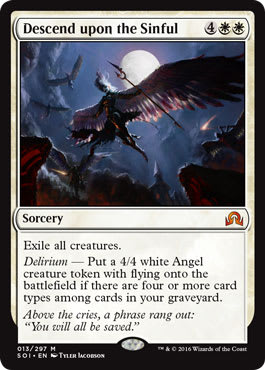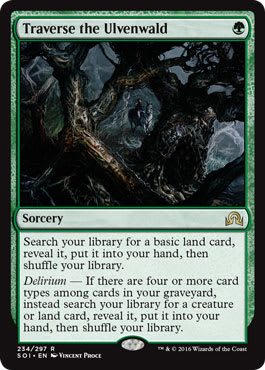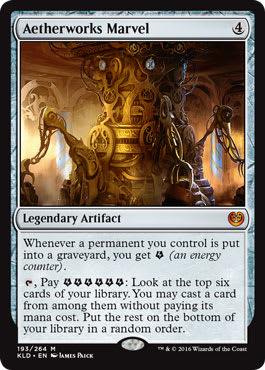Abstract:
- Some “Roman” Mythology
- The Assumptions
- Like I Just Said: The Real Juice is in the Mana Base
- But Wait, There’s More!
- The Rise and Fall of the Roman Empire
- Turning the Page
Some “Roman” Mythology
“I have been on more Friday night dates with you recently than my actual girlfriend, Michael J,” said Roman over some kind of discount chopped steak monstrosity. What was the point of a post-FNM descent into the wilds of Outback Steakhouse if you were going to drown some glorified McDonald’s in liquefied mushroom?
“Hmmm? Um . . . Lucky you, I guess.” I was concentrating on cutting through the allegedly prime rib in front of me. “Remind me never to order this again.”
. . .
Roman texted me late Saturday.
He had lost in the finals of the PPTQ Top 8 draft. Of course I was cheering for the young Apprentice . . . But part of me was excited he had lost. Excited that, finally, the G/W Marvel deck was going to get a last-minute lick in; an actual shot at the basket.
“Bad beats,” I texted back. “Just crush tomorrow.”
After all, I knew he had the tools to do so.
The Assumptions
Back-of-the-envelope mathmetagaming had Standard in a precariously balanced*rock-paper-scissors of U/W Flash, Golgari Delirium, and Marvel variants. U/W had the best cards and a dominating trump over Marvel in Spell Queller . . . The Counterspell that could not be Rejected Ceremoniously nor Negated; at the same time Marvel was difficult for Golgari to disrupt, which put the control Delirium version on the back foot (and was still challenging for the aggro Smuggler's Copter build); finally, B/G either beat itself or U/W, if neither definitively, on style.
Based on a couple of assumptions, I thought this R-P-S format would be vulnerable to disruption. The key is that 2/3 of the metagame could be beaten with the same card, which would allow us to retain the nut of a viable deck while pivoting around that card to win essentially all the matchups.
- Assume Marvel, and assume Marvel in its natural state can maintain its advantage over B/G decks + any random creature / aggro decks that are less powerful than B/G (e.g. Prized Amalgam decks)
- The reason U/W is advantaged over Marvel is primarily Spell Queller. Spell Queller answers Aetherworks Marvel itself while putting Marvel on a clock. Spell Queller can be beaten, a bit non-intuitively, by cards that cost five or more as long as you have the capacity to catch up. This is best illustrated by Osyp Lebedowicz’s Tragic Arrogance Open win with G/W Tokens. Osyp played three copies of a sweeping 5-drop that neither Spell Queller nor Archangel Avacyn could interact with. He beat Spell Queller / Avacyn decks in both the Top 4 and Top 2 (including standout Chris Andersen) . . . And right now we don’t have to deal with Collected Company.
- Marvel decks achieve “proxy” wins, rather than wins outright, by resolving Emrakul, the Promised End or other fatties. Most interaction succeeds (Spell Queller, to a lesser degree Ceremonious Rejection) or fails (Transgress the Mind, too often) by trying to stop Marvel from getting where they are trying to go. Another route is to let them get there but beat them anyway. By the way they tend to be pretty good at getting there, potentially even through interaction; but beating them once they think they’ve already won? That is another chapter to the book, entirely.
Opponents 2 and 3 could be beaten with a single card played at maximum speed and redundancy. Lucky ducky, this card (especially at instant speed) happens to be pretty good against everything.
Marvel plays more powerful cards than Golgari, generally. Or the same cards (like Ishkanah, Grafwidow). The main thing is that Golgari is full of cards like Grasp of Darkness that don’t interact with Marvel very well, and even when it gets its cards out, it is not very good at overcoming Marvel’s power at its speed (the slowest of Standard’s R-P-S). So forget about that. We win either way.
U/W is the part that requires the most thoughtfulness. In the G/W Marvel strategy we are essentially trading in up to four copies of Ishkanah, Grafwidow and Descend Upon the Sinful as “hits”. The G/W build only has three total Eldrazi Legends, but more copies of Traverse the Ulvenwald.
Descend Upon the Sinful is arguably less powerful than any conventional Marvel hit, but in concert with Ishkanah, it does the same thing that Osyp did with Tragic Arrogance: It gives our G/W deck a card that neither Spell Queller nor Archangel Avacyn can beat; in this deck it also gives us a 4/4 body we can use to potentially win. So it’s a semi-soft lock, not just a sweeper.
Descend Upon the Sinful (along with Fumigate in the sideboard) is secretly how we win the mirror, too. You see, other Marvel decks get all fancy about getting somewhere. That “place” is generally Emrakul, the Promised End. But if we play all sweepers, they can’t actually beat us with it. What are they going to do when they take control of our turn? Descend and forget to make the 4/4? We neuter their end game while simultaneously covering the bases on go-wide semi-soft locks like Whirler Virtuoso and Ishkanah, Grafwidow.
The mix and end game selection in this deck is very precise for beating the pre-Aether Revolt Standard R-P-S, but the real juice is in the mana base.
Like I Just Said: The Real Juice is in the Mana Base
The mana base took the most thought and work. My first challenge was to figure out which dual lands, if any, I wanted. Standard is lousy with effective G/W dual lands. Should I play Fortified Village or Canopy Vista? Both? A mix?
It turns out that the answer is neither.
This deck, with eight copies of Lay of the Land on turn one (not to mention Vessel of Nascency) just really wants to hit ![]() . Fortified Village is iffy on turn one, and Canopy Vista is a big old bagel. You just want basic Forest. Your White mana is easily accomplished by the fourteen routes to basic Plains. There is no downside to just going for Plains with all your searching unless your opponent plays Ulamog, the Ceaseless Hunger (and even then, there is no guarantee the opponent will understand what he is supposed to target).
. Fortified Village is iffy on turn one, and Canopy Vista is a big old bagel. You just want basic Forest. Your White mana is easily accomplished by the fourteen routes to basic Plains. There is no downside to just going for Plains with all your searching unless your opponent plays Ulamog, the Ceaseless Hunger (and even then, there is no guarantee the opponent will understand what he is supposed to target).
Evolving Wilds is a necessary evil. Not only is it a synergistic include with the Plains / Forest structure, it is a surprisingly important way to achieve Delirium. Golgari Delirium decks haven’t always played four copies, but this deck actually needs all the help it can get because Descend and Ishkanah have to do hard-cast duty against U/W.
The deck has a ton of single Green availability and can easily get any amount of White mana necessary to cast its Angels and sweepers. In this deck Westvale Abbey is simply a land that enters the battlefield untapped (great!) but is also a two-card combo with Ishkanah, Grafwidow. In most Marvel decks Ishkanah is only a concession to U/W (which it primarily is here, for sure); but since we aren’t pushing for a third color we get to use Westvale Abbey in concert with Ishkanah to make the Profane Prince. There are ways to interact with it for sure (Reflector Mage, Stasis Snare, and opposing Ulamogs all work) but most of the time the opponent will just be overwhelmed. Combine with the other big hitters? I mean you haven’t lived until you’ve had Ormendahl and Bruna both attacking on the same turn. Plus, as a four-Traverse the Ulvenwald deck, we can complete the two-card combo from either side.
But Wait, There’s More!
This is the actual deck Roman played to his PPTQ Top 8:
G/W Marvel ? Kaladesh Standard| Roman
- Creatures (10)
- 1 Ulamog, the Ceaseless Hunger
- 2 Emrakul, the Promised End
- 3 Ishkanah, Grafwidow
- 4 Servant of the Conduit
- Instants (4)
- 4 Grapple with the Past
- Sorceries (12)
- 4 Attune with Aether
- 4 Descend upon the Sinful
- 4 Traverse the Ulvenwald
- Enchantments (4)
- 4 Vessel of Nascency
- Artifacts (8)
- 4 Aetherworks Marvel
- 4 Woodweaver's Puzzleknot
- Lands (22)
- 10 Forest
- 2 Plains
- 2 Westvale Abbey
- 4 Aether Hub
- 4 Evolving Wilds
- Sideboard (15)
- 3 Gisela, the Broken Blade
- 2 Bruna, the Fading Light
- 3 Natural State
- 2 Blessed Alliance
- 1 Nissa, Vital Force
- 1 World Breaker
- 1 Sigarda, Heron's Grace
- 2 Fumigate
Those 8-9 Angels were all Roman. My original sideboard had us transforming into Nissa, Vital Force and Gideon, Ally of Zendikar, but Gisela, the Broken Blade provides so much more immediate impact on four than Gideon in this kind of a deck, and Gisela is better against projected sideboard cards. Bruna is super in-theme in this deck, especially if you go Gisela [trade] into Marvel. You can easily hit a turn five Brisela, Voice of Nightmares, which is basically unbeatable.
Had I played in that tournament I would have run all four copies of Gisela and no World Breakers. This was certainly a card we talked about, but having played the deck a lot I don’t think it has sufficient traditional Ramp (not to mention no basic Wastes) to really abuse the World Breaker. On balance I have had a lot of success with third and fourth turn Giselas when the opponent has left up interaction (most commonly Negate or Ceremonious Rejection). Since opponents often cut their low powered point removal, Gisela can do a lot of damage (both literally and figuratively) . . . Plus, four copies just makes it that much easier to link up with Bruna.
For what it’s worth, I thought Natural State sucked. I tested with four copies and it pretty much always under-performed. If I were to run the old format again, I would play no more than two.
The Rise and Fall of the Roman Empire
The first text I got on Sunday was about some ignominious draw against B/G. I don’t even know how that happens. Turns out he just wasn’t familiar enough with the deck.
After that Roman got his head on straight and it was all about life on “easy mode” including a convincing 2-0 over Invitational Champion Liam Lonergan and his Vehicles deck. Undefeated, ultimately, Top 8, etc.
The ending is sad, though. After a so-close showing at last month’s RPTQ (Top 16), and a PPTQ finals loss 24 hours earlier, Roman failed to find Marvel in any game and lost to the U/W dream draw of Inspector / Copter / Gideon. Beatable? Not if you don’t draw Aetherworks Marvel.
Happy the deck did well (if not well enough), sad for my buddy, I thought that was it for this one. Another small, if (maybe?) great, deck that never got the coverage it might have with some different timing. I certainly wasn’t planning on this as the topic of my second article here.
And then yesterday** happened. With the banning of both Emrakul, the Promised End and Smuggler's Copter in Standard, maybe G/W Marvel might have legs in the upcoming format . . .
Turning the Page
The things that make this deck unique are still in place. The loss of Emrakul hurts for sure, but it arguably hurts us least among Emrakul-driving decks. Certainly we lose less — given our preference for Descend Upon the Sinful as our semi-soft lock of choice — than any aggro deck lost with Smuggler's Copter. And Roman’s Top 8 nemesis U/W will be less prevalent having lost both Smuggler's Copter and Reflector Mage. On balance, we keep all the things that let us keep up with Spell Queller.
The real question is how this deck might be able to handle the new “Splinter Twin” type combo that threatens to dominate Standard once Felidar Guardian starts hitting playmats. I told Roman that this deck was the midrange-iest deck in Standard . . . It only looks like a Tinker deck; and midrange decks don’t historically fare well against infinite combo decks.
But, again, yesterday happened.
On the special bonus episode of Top Level Podcast my partner Patrick Chapin posited a potential solution for G/W decks in a world defined by powerful combos and unusual mana engines:
See what this does? Not only does Thalia mess up people who are playing all Aether Hubs and dual lands, but it is the perfect foil to a deck that tries to make infinite Felidar Guardians on turn four. First of all, three is less than four so a G/W deck can [probably out of the sideboard] play Thalia with the reasonable expectation of pre-empting the infinite combo. But once Thalia is on the battlefield, it doesn’t matter how many Cat Beasts you make . . . None of them can attack.
Live?
I dunno. But if you had told me two months ago the best Marvel deck would be defined by the ability to make a 4/4 at instant speed, I probably would have raised The Rock’s eyebrow in your direction.
LOVE
MIKE
* I use this word loosely.
** I’m writing this on 1/10






























